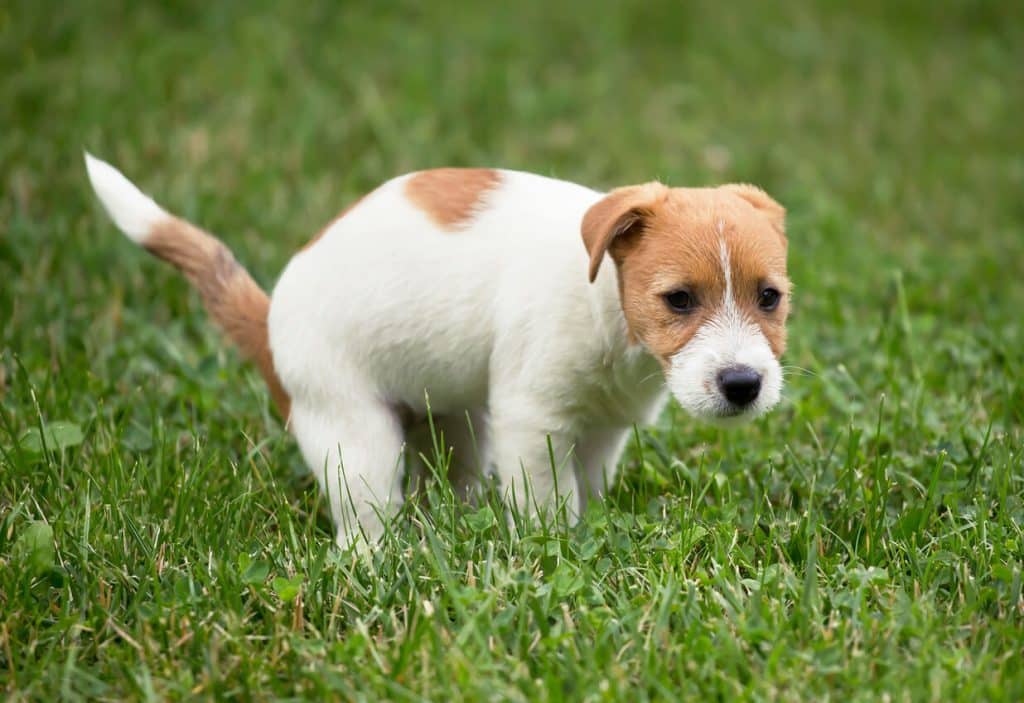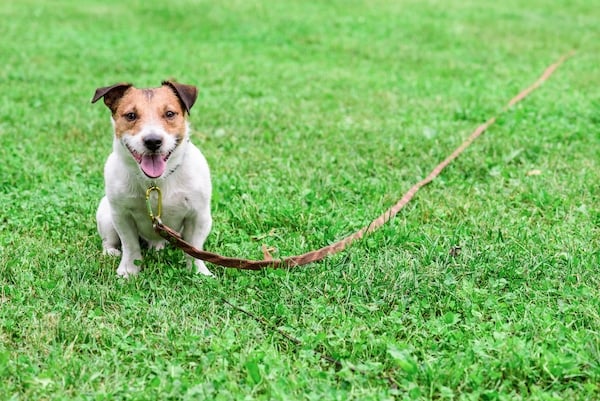- Not a substitute for professional veterinary help.
As many dog parents know, it can be tricky to train a dog to poop anywhere they’re not naturally inclined to, whether that’s on leash, on cue, or just in an unfamiliar spot. If you’re struggling to show your puppy the ropes—or offer a training refresher for a older dog—you’re not alone.
With the help of Paige Gordon of SpiritDog Training, we review how to teach a dog to poop in the right place, plus what makes it so hard and how to troubleshoot. We’ll also cover when it’s time to restart potty training.
Reasons Dogs Won’t Poop
There are a lot of reasons that dogs won’t poop exactly when and where you want them to. Ms. Gordon explains that it may come down to the fact that, just like us, dogs have preferences!
Most of the time, your dog’s reluctance is normal, has an explanation, and can be addressed with positive reinforcement training.
Confusing potty training rules
For puppies and very young dogs, a reluctance to poop usually just means they aren’t fully potty trained yet and may not associate a trip outside with pooping.
For adult dogs, it may be that your dog’s previous potty training experiences weren’t consistent, positive, or just the same as your rules.
Leash and confinement anxiety
Some dogs feel confined by having to poop on a leash, Ms. Gordon explains. They may want to potty with cover (trees and bushes), or they may want to have free rein to sniff and circle to find just the right spot. A short leash can exacerbate the problem.
Additionally, some types of leashes (especially retractable ones) can cause a pulling sensation or a noise distraction that can be counterproductive.
Scared of the environment
Sometimes, the environment itself can be the source of the problem. As Ms. Gordon points out, anxious and reactive dogs might just be too stressed to go. Other dogs, noises, or lots of surrounding activity can be enough to trigger your dog and make pooping out of the question.
Lack of positive association with pooping
If your dog doesn’t have a positive association with pooping outside or on a leash, they may be reluctant to try. This can happen if pet parents are always in a hurry to get their dog to go, which can create stress.
Similarly, if dogs aren’t given encouraging feedback (or especially if given negative feedback), they may not feel great about pooping outside or on a leash.

Wavetop via iStock
How To Help Your Dog Poop on the Leash or Outside
If you’re struggling to get your dog to poop outside or when they’re on a leash, your goal is to build up positives around the experience. That means getting rid of things that might be a negative, boosting their confidence with praise, and offering rewards for steps in the right direction.
Rebuild your dog’s confidence
If anxiety is at the root of the problem, rebuilding your dog’s confidence is a good first step. Often, this means providing them with a stress-free environment for pooping.
Try limiting distractions like:
- Noise
- Other dogs and people
- Traffic
You’ll also want to avoid becoming a distraction yourself. Don’t rush your dog, and try not to convey through voice or body language that you’re in a hurry. Ms. Gordon recommends scheduling plenty of time in the beginning so that your dog (and you) don’t feel pressured.
Retrain positive associations
In many cases, dogs have trouble pooping outside or on a leash because they lack positive associations. Good cueing and positive feedback can help.
First, decide on a cueing word to let your dog know that it’s time to poop. This can be as simple as “go potty.” Use this cue to prepare your dog to get down to business. When they do what you want, be effusive in your praise and reward hugely.
You can also try timing your dog’s potty breaks with their eating schedule to up the chances that they’ll have the urge to go when you take them out.
Get new gear
Sometimes the gear itself can be a source of the problem. If your dog wants to be able to explore a larger space as they pick their spot, they may need a longer lead. If you can’t use a longer lead because of restrictions, you may need to be ready to move about the space with your dog as they find their spot.

alexei_tm via iStock
Restart Potty Training
On rare occasions, you might need to restart potty training. This is usually the case when your dog is consistently having accidents in your home. Here’s how:
- Monitor your dog or puppy very closely, use dog gates limit their access to areas of the home where cleanup is possible, and be ready to take them out when they show signs that they need to go.
- Take care to develop a consistent schedule of feeding, drinking, playing, and going outside to help to get your dog on a predictable routine.
- Watch your dog to ensure that they actually go on potty breaks. If they don’t, bring them back inside, but try again in fifteen or twenty minutes.
- Avoid any negative reinforcement, like punishing your dog for mistakes or exhibiting frustrated body language. These can be damaging to your dog’s confidence and to the training process.
Throughout the process, be consistent, be positive, and reward your dog when they do the right thing. You’ll be back on track in no time!



